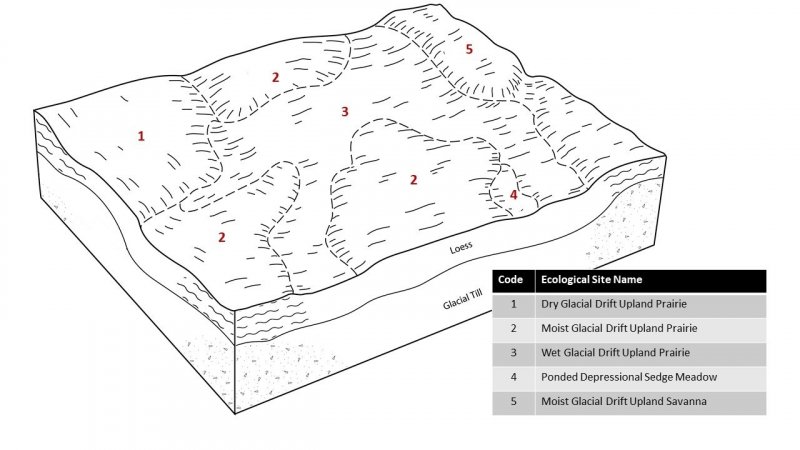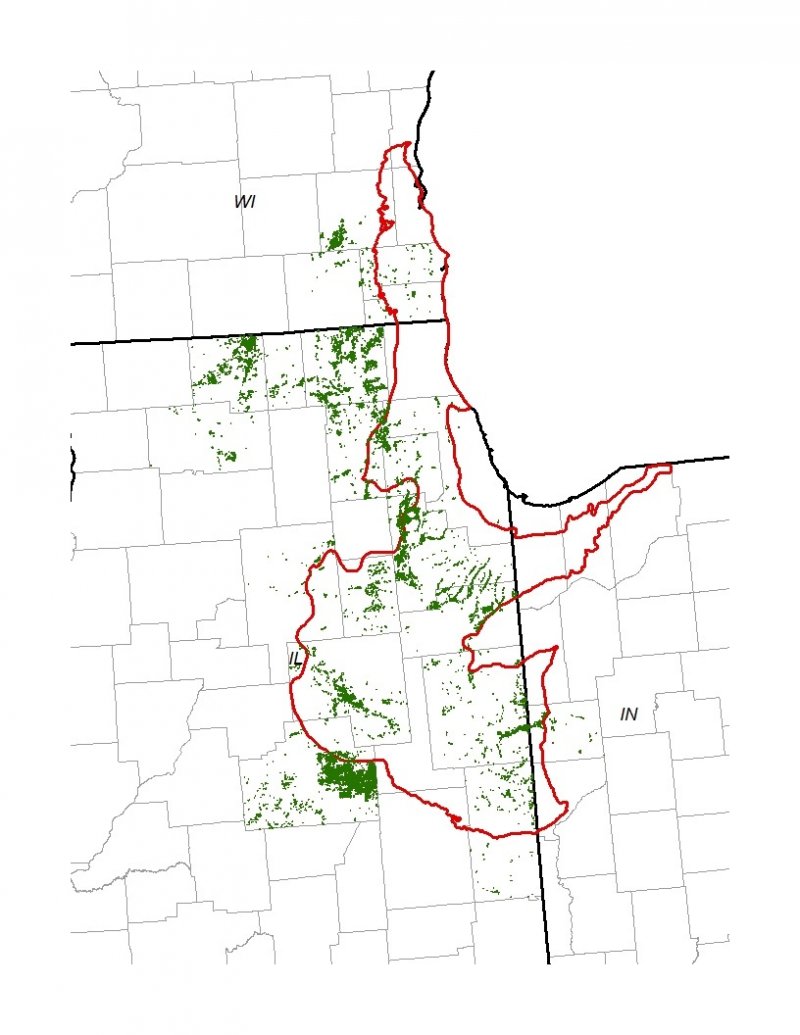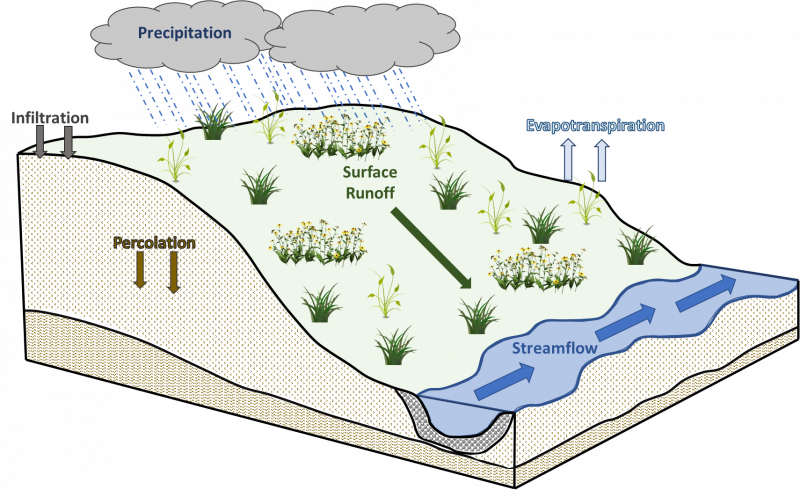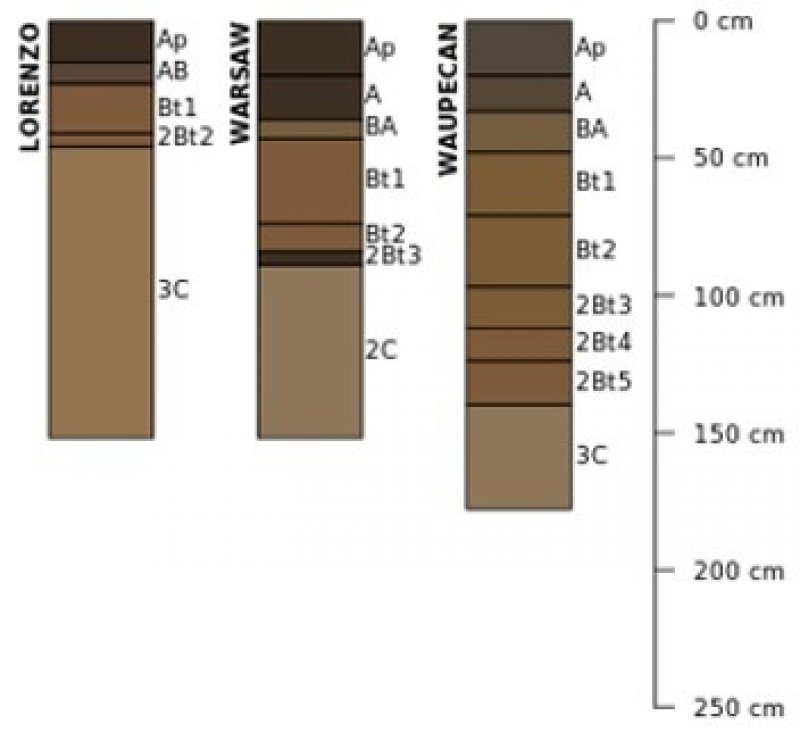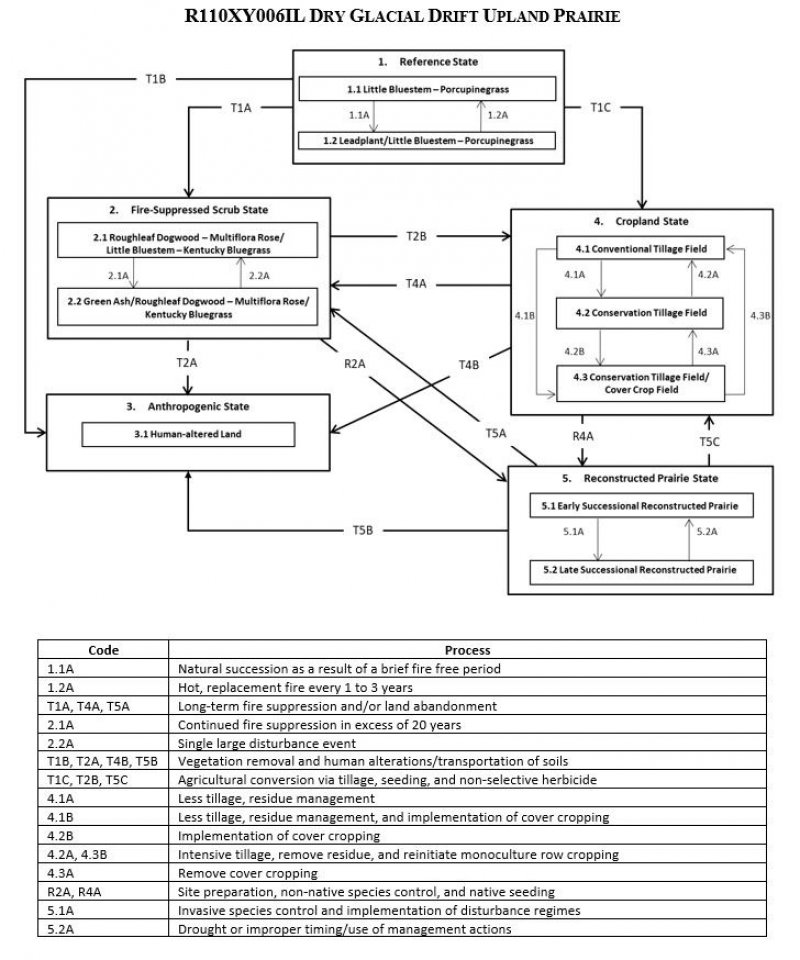Ecological dynamics
The information in this Ecological Site Description, including the state-and-transition model (STM), was developed based on historical data, current field data, professional experience, and a review of the scientific literature. As a result, all possible scenarios or plant species may not be included. Key indicator plant species, disturbances, and ecological processes are described to inform land management decisions.
The MLRA lies within the tallgrass prairie ecosystem of the Midwest, but a variety of environmental and edaphic factors resulted in landscape that historically supported prairies, savannas, forests, and various wetlands. Dry Glacial Drift Upland Prairies form an aspect of this vegetative continuum. This ecological site occurs on uplands on well-drained soils. Species characteristic of this ecological site consist of heliophytic, fire-adapted herbaceous vegetation.
Fire is a critical disturbance factor that maintains Dry Glacial Drift Upland Prairies. Fire intensity typically consisted of periodic, low-intensity surface fires occurring every 1 to 3 years (LANDFIRE 2009). Ignition sources included summertime lightning strikes from convective storms and bimodal, human ignitions during the spring and fall seasons. Native Americans regularly set fires to improve sight lines for hunting, driving large game, improving grazing and browsing habitat, agricultural clearing, and enhancing vital ethnobotanical plants (Barrett 1980).
Drought and herbivory by native ungulates have also played a role in shaping this ecological site. The periodic episodes of reduced soil moisture in conjunction with the well-drained soils have favored the proliferation of plant species tolerant of such conditions. Drought can also slow the growth of plants and result in dieback of certain species. Bison (Bos bison) grazing, while present, served a more limited role in community composition and structure than lands further west. Prairie elk (Cervus elaphus) and white-tailed deer (Odocoileus virginianus) likely contributed to woody species reduction but are also considered to be of a lesser impact compared to the west (LANDFIRE 2009). When coupled with fire, periods of drought and herbivory can further delay the establishment of woody vegetation (Pyne et al. 1996).
Today, Dry Glacial Drift Upland Prairies are limited in their extent, having been type-converted to agricultural production land or other human-modified landscapes. Remnants that do exist show evidence of indirect anthropogenic influences from fire suppression and non-native species invasion. A return to the historic plant community may not be possible following extensive land modification, but long-term conservation agriculture or prairie reconstruction efforts can help to restore some biotic diversity and ecological function. The state-and-transition model that follows provides a detailed description of each state, community phase, pathway, and transition. This model is based on available experimental research, field observations, literature reviews, professional consensus, and interpretations.
State 1
Reference State
The reference plant community is categorized as a mid- to tallgrass prairie community, dominated by herbaceous vegetation. The two community phases within the reference state are dependent on fire. The intensity and frequency alter species composition, cover, and extent, while regular fire intervals keep woody species from dominating. Drought and herbivory have more localized impacts in the reference phases, but do contribute to overall species composition, diversity, cover, and productivity.
Community 1.1
Little Bluestem - Porcupinegrass
Sites in this reference community phase are dominated by a mix of mostly mid and tallgrasses and various forbs. Vegetative cover is continuous (95 to 100 percent) and plants can reach heights between 3 and 6 feet tall (LANDFIRE 2009; NatureServe 2018). Little bluestem, porcupinegrass, and Indiangrass are the dominant warm-season grasses present on the site. Other grasses present can include big bluestem, sideoats grama, and prairie dropseed. Characteristic forbs can include pale purple coneflower, tall blazing star, and tall cinquefoil (White and Madany 1978; NatureServe 2018). Fire with low intensity will maintain this community phase, but a few years without fire allows the community to mature, shifting to phase 1.2 (LANDFIRE 2009).
Community 1.2
Leadplant/Little Bluestem - Porcupinegrass
This reference community phase represents a successional shift following an extended fire return interval. The lack of fire allows limited, low woody shrubs – such as leadplant (Amorpha canescens Pursh) – to develop in the prairie community. Perennial, warm-season grasses and a diversity of forbs continue to be dominant components on the site. A hot, replacement fire every 1 to 3 years will reduce the shrub cover, shifting the site back to community phase 1.1 (LANDFIRE 2009).
Pathway 1.1A
Community 1.1 to 1.2
Natural succession as a result of a brief fire-free period.
Pathway 1.2A
Community 1.2 to 1.1
Hot, replacement fire every 1 to 3 years.
State 2
Fire-Suppressed Scrub State
Long-term fire suppression can transition the reference prairie community into a woody-invaded shrub-prairie state. This state is evidenced by a well-developed shrub layer and sparse trees (LANDFIRE 2009). Proximity to lands that have been altered provide opportunities for non-native invasive species to readily colonize this state, thereby reducing the native biodiversity and changing the vegetative community.
Community 2.1
Roughleaf Dogwood - Multiflora Rose/Little Bluestem - Kentucky Bluegrass
This community phase represents the early stages of fire-suppression. In as little as six fire-free years, the prairie is disrupted and succeeded by woody shrubs. Native species - e.g., roughleaf dogwood (Cornus drummondii C.A. Mey) and black raspberry (Rubus occidentalis L.) - and non-native species - e.g., multiflora rose (Rosa multiflora Thunb.) - can form dense thickets with cover reaching up to 30 percent and plant heights as tall as 9 feet (LANDFIRE 2009). Some native prairie plants will persist, but non-native herbaceous species tolerant of shading encroach on the site.
Community 2.2
Green Ash/Roughleaf Dogwood - Multiflora Rose/Kentucky Bluegrass
Sites falling into this community phase have a well-established shrub layer, and scattered trees begin to develop in the continued absence of fire. The shrub canopy can be diverse, including both native and non-native species. Roughleaf dogwood, black raspberry, and eastern poison ivy (Toxicodendron radicans (L.) Kuntze) are common natives, and multiflora rose is a frequently invading non-native. Green ash (Fraxinus pennsylvanica Marshall), common hackberry (Celtis occidentalis L.), and elms (Ulmus L.) may be some encroaching native trees. The non-native white mulberry (Morus alba L.) may also be encountered.
Pathway 2.1A
Community 2.1 to 2.2
Continued fire suppression in excess of 20 years.
Pathway 2.2A
Community 2.2 to 2.1
Single large disturbance event such as selective removal of woody species.
State 3
Anthropogenic State
The anthropogenic state occurs when the reference state is cleared and developed for human use and inhabitation, such as for commercial and housing developments, landfills, parks, golf courses, cemeteries, earthen spoils, etc. The native vegetation has been removed and soils have either been altered in place (e.g. cemeteries) or transported from one location to another (e.g. housing developments). Most of the soils in this state have 50 to 100 cm of overburden on top of the natural soil. This natural material can be determined by observing a buried surface horizon or the unaltered subsoil, till, or lacustrine parent materials. This state is generally considered permanent.
Community 3.1
Human-altered land
Sites in this community phase have had the native plant community removed and soils heavily re-worked in support of human development projects.
State 4
Cropland State
The continuous use of tillage, row-crop planting, and chemicals (i.e., herbicides, fertilizers, etc.) has effectively eliminated the reference community and many of its natural ecological functions in favor of crop production. Corn and soybeans are the dominant crops for the site, and common wheat (Triticum aestivum L.) and alfalfa (Medicago sativa L.) may be rotated periodically. These areas are likely to remain in crop production for the foreseeable future.
Community 4.1
Conventional Tillage Field
Sites in this community phase typically consist of monoculture row-cropping maintained by conventional tillage practices. They are cropped in either continuous corn or corn-soybean rotations. The frequent use of deep tillage, low crop diversity, and bare soil conditions during the non-growing season negatively impacts soil health. Under these practices, soil aggregation is reduced or destroyed, soil organic matter is reduced, erosion and runoff are increased, and infiltration is decreased, which can ultimately lead to undesirable changes in the hydrology of the watershed (Tomer et al. 2005).
Community 4.2
Conservation Tillage Field
This community phase is characterized by rotational crop production that utilizes various conservation tillage methods to promote soil health and reduce erosion. Conservation tillage methods include strip-till, ridge-till, vertical-till, or no-till planting systems. Strip-till keeps seedbed preparation to narrow bands less than one-third the width of the row where crop residue and soil consolidation are left undisturbed in-between seedbed areas. Strip-till planting may be completed in the fall and nutrient application either occurs simultaneously or at the time of planting. Ridge-till uses specialized equipment to create ridges in the seedbed and vegetative residue is left on the surface in between the ridges. Weeds are controlled with herbicides and/or cultivation, seedbed ridges are rebuilt during cultivation, and soils are left undisturbed from harvest to planting. Vertical-till systems employ machinery that lightly tills the soil and cuts up crop residue, mixing some of the residue into the top few inches of the soil while leaving a large portion on the surface. No-till management is the most conservative, disturbing soils only at the time of planting and fertilizer application. Compared to conventional tillage systems, conservation tillage methods can improve soil ecosystem function by reducing soil erosion, increasing organic matter and water availability, improving water quality, and reducing soil compaction.
Community 4.3
Conservation Tillage Field/Alternative Crop Field
This community phase applies conservation tillage methods as described above as well as adds cover crop practices. Cover crops typically include nitrogen-fixing species (e.g., legumes), small grains (e.g., rye, wheat, oats), or forage covers (e.g., turnips, radishes, rapeseed). The addition of cover crops not only adds plant diversity but also promotes soil health by reducing soil erosion, limiting nitrogen leaching, suppressing weeds, increasing soil organic matter, and improving the overall soil ecosystem. In the case of small grain cover crops, surface cover and water infiltration are increased, while forage covers can be used to graze livestock or support local wildlife. Of the three community phases for this state, this phase promotes the greatest soil sustainability and improves ecological functioning within a cropland system.
Pathway 4.1A
Community 4.1 to 4.2
Tillage operations are greatly reduced, crop rotation occurs on a regular interval, and crop rotation occurs on a regular interval, and crop residue remains on the soil surface.
Pathway 4.1B
Community 4.1 to 4.3
Tillage operations are greatly reduced or eliminated, crop rotation occurs on a regular interval, crop residue remains on the soil surface, and cover crops are planted following crop harvest.
Pathway 4.2A
Community 4.2 to 4.1
Intensive tillage is utilized, and monoculture row-cropping is established.
Pathway 4.2B
Community 4.2 to 4.3
Cover crops are implemented to minimize soil erosion.
Pathway 4.3B
Community 4.3 to 4.1
Intensive tillage is utilized, cover crop practices are abandoned, monoculture row-cropping is established, and crop rotation is reduced or eliminated.
Pathway 4.3A
Community 4.3 to 4.2
Cover crop practices are abandoned.
State 5
Reconstructed Prairie State
Prairie reconstructions have become an important tool for repairing natural ecological functions and providing habitat protection for numerous grassland dependent species. Because the historic plant and soil biota communities of the tallgrass prairie were highly diverse with complex interrelationships, historic prairie replication cannot be guaranteed on landscapes that have been so extensively manipulated for extended timeframes (Kardol and Wardle 2010; Fierer et al. 2013). Therefore, ecological restoration should aim to aid the recovery of degraded, damaged, or destroyed ecosystems. A successful restoration will have the ability to structurally and functionally sustain itself, demonstrate resilience to the natural ranges of stress and disturbance, and create and maintain positive biotic and abiotic interactions (SER 2002). The reconstructed prairie state is the result of a long-term commitment involving a multi-step, adaptive management process. Diverse, species-rich seed mixes are important to utilize as they allow the site to undergo successional stages that exhibit changing composition and dominance over time (Smith et al. 2010). On-going management via prescribed fire and/or light grazing can help the site progress from an early successional community dominated by annuals and some weeds to a later seral stage composed of native, perennial grasses, forbs, and a few shrubs. Establishing a prescribed fire regimen that mimics natural disturbance patterns can increase native species cover and diversity while reducing cover of non-native forbs and grasses. Light grazing alone can help promote species richness, while grazing accompanied with fire can control the encroachment of woody vegetation (Brudvig et al. 2007).
Community 5.1
Early Successional Reconstructed Prairie
This community phase represents the early community assembly from prairie reconstruction and is highly dependent on the seed mix utilized and the timing and priority of planting operations. The seed mix should look to include a diverse mix of cool-season and warm-season annual and perennial grasses and forbs typical of the reference state (e.g., little bluestem, porcupinegrass, Indiangrass, tall blazing star). Cool-season annuals can help provide litter that promotes cool, moist soil conditions to the benefit of the other species in the seed mix. The first season following site preparation and seeding will typically result in annuals and other volunteer species forming a majority of the vegetative cover. Control of non-native species, particularly perennial species, is crucial at this point to ensure they do not establish before the native vegetation (Martin and Wilsey 2012). After the first season, native warm-season grasses should begin to become more prominent on the landscape.
Community 5.2
Late Successional Reconstructed Prairie
Appropriately timed disturbance regimes (e.g., prescribed fire) applied to the early successional community phase can help increase the beta diversity, pushing the site into a late successional community phase over time. While prairie communities are dominated by grasses, these species can suppress forb establishment and reduce overall diversity and ecological function (Martin and Wilsey 2006; Williams et al. 2007). Reducing accumulated plant litter from perennial bunchgrasses allows more nutrients and light to become available for forb recruitment, allowing greater ecosystem complexity (Wilsey 2008).
Pathway 5.1A
Community 5.1 to 5.2
Selective herbicides are used to control non-native species, and prescribed fire and/or light grazing helps to increase the native species diversity and control woody vegetation.
Pathway 5.2A
Community 5.2 to 5.1
Reconstruction experiences a decrease in native species diversity from drought or improper timing of management actions (e.g., reduced fire frequency, use of non-selective herbicides).
Transition T1A
State 1 to 2
Long-term fire suppression transitions the site to the fire-suppressed scrub state (2).
Transition T1B
State 1 to 3
Vegetation removal and human alterations/transportation of soils transitions the site to the anthropogenic state (3).
Transition T1C
State 1 to 4
Tillage, seeding of agricultural crops, and non-selective herbicide transition the site to the cropland state (4).
Transition T2A
State 2 to 3
Vegetation removal and human alterations/transportation of soils transitions the site to the anthropogenic state (3).
Transition T2B
State 2 to 4
Tillage, seeding of agricultural crops, and non-selective herbicide transition this site to the cropland state (4).
Restoration pathway R2A
State 2 to 5
Site preparation, invasive species control, and seeding native species transition this site to the reconstructed prairie state (5).
Transition T4A
State 4 to 2
Land abandonment transitions the site to the fire-suppressed scrub state (2).
Transition T4B
State 4 to 3
Vegetation removal and human alterations/transportation of soils transitions the site to the anthropogenic state (3).
Restoration pathway R4A
State 4 to 5
Site preparation, invasive species control, and seeding native species transition this site to the reconstructed prairie state (5).
Transition T5A
State 5 to 2
Land abandonment transitions the site to the fire-suppressed scrub state (2).
Transition T5B
State 5 to 3
Vegetation removal and human alterations/transportation of soils transitions the site to the anthropogenic state (3).
Transition T5C
State 5 to 4
Tillage, seeding of agricultural crops, and non-selective herbicide transition this site to the cropland state (4).

